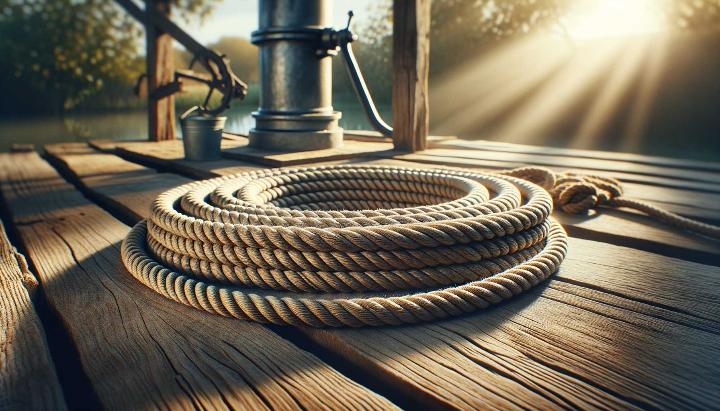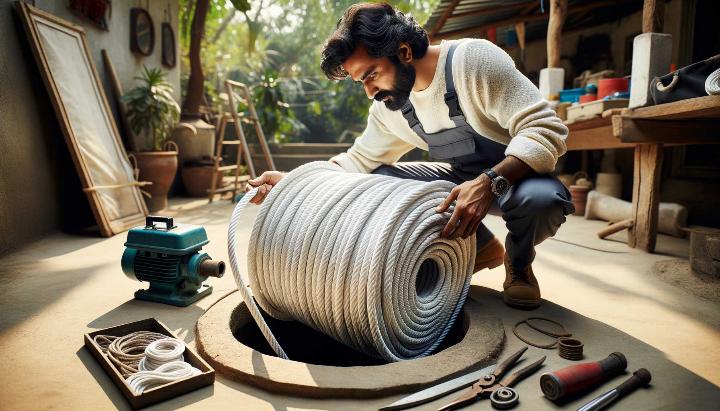Have you ever wondered what keeps a well pump securely suspended hundreds of metres below the ground? The unsung hero of well systems is the well rope, and understanding its strength is crucial for ensuring safety and efficiency. In this post, we'll dive deep into the world of 3 strand rope strength and its application in well rope systems.
When it comes to well rope, not all ropes are created equal. The 3 strand rope, with its unique construction and impressive strength-to-weight ratio, has become a go-to choice for many well operators. But what makes it so special?
At iRopes, we've harnessed the power of 3 strand nylon twisted rope to create a high-quality solution for well applications. Our rope's high elongation properties make it an excellent choice not only for wells but also for anchoring, mooring, and towing. Join us as we explore the science behind 3 strand rope strength and discover why it's the backbone of reliable well systems worldwide.
Well Rope: Definition and Specific Requirements
When it comes to well systems, the unsung hero keeping everything together is the well rope. But what exactly is this crucial component, and why is it so important? Let's dive in and explore the world of well ropes together.
Well rope, also known as safety rope, is a sturdy lifeline that connects submersible pumps to well heads. Its primary function? To prevent the catastrophic separation of pipes in wells. Imagine losing your expensive pump down a deep well – not a pleasant thought, is it?
Types of Safety Rope for Well Pumps
Now, you might be wondering what makes a good well rope. The answer lies in the material and construction. Polypropylene is the star player here, especially for submersible pumps nestled more than 200 feet deep. Why? It's like the Superman of rope materials – resistant to water and mildew, and tough as nails.

But it's not just about the material. The specific requirements for well ropes are like a recipe for success:
- Strength: It needs to be able to support the weight of the pump and withstand the forces of water.
- Durability: Long-lasting performance is crucial, as replacing the rope frequently would be a pain.
- Resistance to abrasion: The rope must stand up to the constant friction against well walls.
NFPA Standards for Well Rope Selection
Now, here's where things get a bit technical, but stick with me – it's important stuff. The National Fire Protection Association (NFPA) has set some ground rules for these ropes. NFPA Standard 1983 is the holy grail of life safety rope requirements, and it applies to our trusty well ropes too.
These standards specify things like elongation limits, ensuring that when you're pulling up that pump, the rope isn't stretching like a rubber band. It's all about safety and reliability, folks.
So, next time you're sipping water from your tap, spare a thought for the humble well rope. It's working tirelessly, hundreds of feet below ground, keeping your water flowing and your pump safely in place. Who knew such a simple tool could be so vital?
Understanding 3 Strand Rope Strength
When it comes to well rope applications, understanding the strength of 3 strand rope is crucial. As someone who's spent years working with various rope types, I can tell you that 3 strand rope has some unique characteristics that make it a popular choice for well rope. Let's dive into the nitty-gritty of what makes this rope tick.
Factors Affecting 3 Strand Rope Strength
The strength of a 3 strand rope isn't just about the material it's made from. Several factors come into play:
- Material properties: Nylon and polyester are common choices, each offering different strength-to-weight ratios and resistance to environmental factors.
- Rope diameter: Generally, the thicker the rope, the stronger it is. But there's a sweet spot between strength and practicality.
- Twisting technique: The way the strands are twisted together can significantly impact the rope's overall strength.
I once worked on a project where we tested ropes of the same diameter but different twisting techniques. The difference in breaking strength was astounding - up to 20% in some cases!
For those interested in a deeper dive into rope types and understanding their strength dynamics, you might want to visit our detailed guide on rope types and strength.

Comparing 3 Strand vs Braided Rope Strength
Now, you might be wondering how 3 strand rope stacks up against its braided counterpart. Here's the lowdown:
- Breaking strength: Braided ropes typically have higher breaking strengths than 3 strand ropes of the same diameter.
- Flexibility: 3 strand ropes are generally more flexible, making them easier to handle and tie.
- Abrasion resistance: 3 strand ropes often have better abrasion resistance, which is crucial for well rope applications.
But here's the kicker - while braided ropes might win in raw strength, 3 strand ropes have a unique advantage. Their construction allows for easier splicing and repair, which can be a game-changer when you're working with well ropes that need to last.
Have you ever had to splice a rope hundreds of feet down a well? It's no picnic, let me tell you. The simplicity of 3 strand rope can save you hours of frustration in these situations.
If you want to explore more on mastering rope techniques, our insights on rope splicing techniques might offer some valuable guidance.
When calculating rope strength, remember this rule of thumb: the safe working load is typically about 20% of the rope's breaking strength. So, if you're dealing with a 3 strand rope with a breaking strength of 5,000 pounds, you'd want to keep your working load under 1,000 pounds.
At the end of the day, choosing between 3 strand and braided rope for well applications comes down to balancing strength, practicality, and specific project requirements. What's been your experience with different rope types in well applications? I'd love to hear your thoughts!
3-Strand Nylon Twisted Rope for Well Applications
When it comes to well rope applications, choosing the right material can make all the difference. That's where 3-strand nylon twisted rope comes into play. As someone who's spent years in the field, I can tell you that this rope is a game-changer for well systems.
3-strand nylon twisted rope is exactly what it sounds like – three strands of nylon fibre twisted together to create a strong, durable rope. But what makes it so special for well applications? Let's dive in and explore.
Key Features of 3-Strand Nylon Rope for Wells
There's a reason why 3-strand nylon twisted rope is becoming the go-to choice for well systems. Its unique properties make it ideal for the challenging conditions found in wells:
- Impressive strength-to-weight ratio: This rope punches above its weight, providing robust support without adding unnecessary bulk to your system.
- Excellent shock absorption: The twisting construction allows the rope to absorb sudden jerks or movements, protecting your equipment from damage.
- UV-resistant and rot-proof: Nylon's natural resistance to UV rays and rot means your rope will last longer, even in harsh conditions.
- Flexibility and ease of handling: The rope's pliable nature makes it easy to work with, whether you're installing, maintaining, or repairing your well system.

Selecting the Right Nylon Rope for Your Well System
Choosing the perfect 3-strand nylon twisted rope for your well isn't just about picking the strongest option. Here are some factors to consider:
- Diameter: Generally, a thicker rope means more strength, but it's crucial to balance this with the size of your well and equipment.
- Length: Consider the depth of your well and add extra length for safety and flexibility in installation.
- Weight capacity: Always choose a rope with a breaking strength significantly higher than your expected load.
- Safety factor: A good rule of thumb is to use a safety factor of 5:1 – meaning your rope should be rated for five times the weight it will actually bear.
When it comes to installation and maintenance, remember these tips:
- Proper knot tying: Learn and use the right knots to maintain the rope's integrity.
- Regular inspections: Check your rope frequently for signs of wear or damage.
- Clean storage: When not in use, store your rope in a clean, dry place away from direct sunlight.
From personal experience, I can tell you that investing time in selecting and maintaining the right rope pays off in the long run. It's not just about avoiding equipment failure – it's about peace of mind knowing your well system is secure and efficient.
Explore more about choosing the ideal nylon rope specifically for anchor and mooring applications, such as those used in wells, by visiting our guide on polyester and nylon ropes.
Have you used 3-strand nylon twisted rope in your well system? What has been your experience? Share your thoughts and let's learn from each other's experiences in well rope applications.
```htmlUnderstanding the 3 strand rope strength is essential for well rope applications, ensuring the safety and reliability of well systems. The robust construction of 3 strand rope, with its impressive durability and abrasion resistance, makes it a superior choice over alternatives like braided ropes. In particular, iRopes' 3 strand nylon twisted rope is a standout, boasting high elongation properties that are ideal for applications such as anchor, mooring, and towing. This rope is engineered to not only meet but exceed expectations for well rope, offering a perfect balance of strength, flexibility, and longevity. With a commitment to quality, iRopes ensures their rope made for well applications is thoroughly tested for performance and safety, making them a trusted partner in the industry.
Discover Tailored Solutions for Your Well Rope Needs
Above is our inquiry form. Fill it out to access expert guidance and explore iRopes’ range of customised 3 strand rope solutions for your unique well rope requirements. Our team is ready to assist you in choosing the best rope that suits your specific needs, ensuring efficiency and peace of mind in your operations.
```